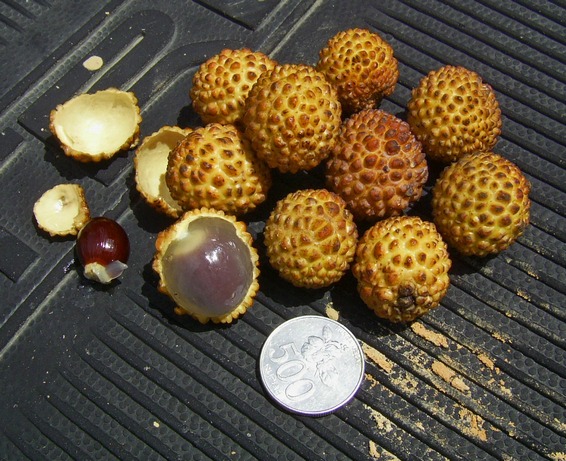|
Pieter Willem Leenhouts
Pieter Willem Leenhouts (1926 – 1 March 2004) was a Dutch botanist. He worked at the National Herbarium of the Netherlands, Rijksherbarium from 1947 until his official retirement in 1991, and then was an honorary member of staff until 1999. He was editor of ''Blumea (journal), Blumea'' from 1973 to 1999. Eponymy *Burseraceae: ''Haplolobus leenhoutsii'' *Loganiaceae: ''Geniostoma leenhoutsii'' *Loganiaceae: ''Strychnos leenhoutsii'' Publications Books * 1959. ''A monograph of the genus Canarium (Burseraceae)''. Edición reimpresa de Ijdo, 475 pp. * 1965. ''Systematisch-morphologische Studien an Terebinthales-Familien: (Bursersaceae, Sapindaceae).'' Volumen 1965, Nº 10 de Mathematisch-naturwissenschaftlich Klasse. Editor Verlag der Akademie der Wissenschaften und der Literatur, 584 pp. * 1966. ''A new Strychnos from Borneo (Loganiaceae).'' 230 pp * 1967. ''Phoenicimon Ridl. (Sapindaceae) is Glycosmis José Francisco Corrêa da Serra, Correa (Rutaceae).'' 452 pp. * 1968b. ' ... [...More Info...] [...Related Items...] OR: [Wikipedia] [Google] [Baidu] |
Hopkinton, Rhode Island
Hopkinton is a town in Washington County, Rhode Island, United States. The population was 8,398 at the 2020 United States census, 2020 census. History Hopkinton is named after Stephen Hopkins (politician), Stephen Hopkins, a signer of the United States Declaration of Independence, Declaration of Independence who was governor of the Colony of Rhode Island and Providence Plantations when the town was partitioned from Westerly, Rhode Island, Westerly and incorporated in 1757. Hopkinton once featured a number of industrial villages, such as Locustville, Moscow, Centerville, and Wood River Iron Works, each being named after the mill which they surrounded. Today only Hope Valley, Rhode Island, Hope Valley, Rockville, Rhode Island, Rockville, Ashaway, and Bradford, Rhode Island, Bradford are recognized with a post office. The town hall is located in the village of Hopkinton City, which was once a stagecoach hub. Geography Hopkinton is found at 41.461 N latitude and 71.778 W longitude ... [...More Info...] [...Related Items...] OR: [Wikipedia] [Google] [Baidu] |
Phoenicimon
''Glycosmis'' is a genus of flowering plants in the citrus family, Rutaceae and tribe Clauseneae. It is in the subfamily Aurantioideae, which also includes genus ''Citrus''. It is a genus of the subtribe Clauseninae, which are known technically as the remote citroid fruit trees.Citrus Variety Collection. College of Natural and Agricultural Sciences. University of California, Riverside. The distribution of the genus includes and . Description Plants of the genus are |
2004 Deaths
This is a list of lists of deaths of notable people, organized by year. New deaths articles are added to their respective month (e.g., Deaths in ) and then linked below. 2025 2024 2023 2022 2021 2020 2019 2018 2017 2016 2015 2014 2013 2012 2011 2010 2009 2008 2007 2006 2005 2004 2003 2002 2001 2000 1999 1998 1997 1996 1995 1994 1993 1992 1991 1990 1989 1988 1987 1986 Earlier years ''Deaths in years earlier than this can usually be found in the main articles of the years.'' See also * Lists of deaths by day * Deaths by year (category) {{DEFAULTSORT:deaths by year ... [...More Info...] [...Related Items...] OR: [Wikipedia] [Google] [Baidu] |
1926 Births
In Turkey, the year technically contained only 352 days. As Friday, December 18, 1926 ''(Julian Calendar)'' was followed by Saturday, January 1, 1927 '' (Gregorian Calendar)''. 13 days were dropped to make the switch. Turkey thus became the last country to officially adopt the Gregorian Calendar, which ended the 344-year calendrical switch around the world that took place in October, 1582 by virtue of the Papal Bull made by Pope Gregory XIII. Events January * January 3 – Theodoros Pangalos declares himself dictator in Greece. * January 8 **Ibn Saud is crowned ruler of the Kingdom of Hejaz. ** Crown Prince Nguyễn Phúc Vĩnh Thuy ascends the throne as Bảo Đại, the last monarch of the Nguyễn dynasty of the Kingdom of Vietnam. * January 16 – A British Broadcasting Company radio play by Ronald Knox about workers' revolution in London causes a panic among those who have not heard the preliminary announcement that it is a satire on broadcasting. * January 21 ... [...More Info...] [...Related Items...] OR: [Wikipedia] [Google] [Baidu] |
Canarium
''Canarium'' is a genus of about 120 species of tropical and subtropical trees, in the family Burseraceae. They grow naturally across tropical Africa, south and southeast Asia, Indochina, Malesia, Australia and western Pacific Islands; including from southern Nigeria east to Madagascar, Mauritius, Sri Lanka and India; from Burma, Malaysia and Thailand through the Malay Peninsula and Vietnam to south China, Taiwan and the Philippines; through Borneo, Indonesia, Timor and New Guinea, through to the Solomon Islands, Vanuatu, New Caledonia, Fiji, Samoa, Tonga and Palau. ''Canarium'' species grow up to large evergreen trees of tall, and have alternately arranged, pinnate leaves. They are dioecious, with male and female flowers growing on separate trees. Species As of January 2024, Plants of the World Online accepts 121 species. The brief species distribution information was sourced from '' Flora Malesiana'', the ''Flora of China'' (series), the ''Australian Tropical Rainforest Pl ... [...More Info...] [...Related Items...] OR: [Wikipedia] [Google] [Baidu] |
Haplolobus (plant)
''Haplolobus'' is a genus of plant in family Burseraceae The Burseraceae are a moderate-sized family of 17-19 genera and about 540 species of woody flowering plants. The actual numbers given in taxonomic sources differ according to taxonomic revision at the time of writing. The Burseraceae are also .... Species include: References Burseraceae genera Taxonomy articles created by Polbot Taxa named by Herman Johannes Lam {{sapindales-stub ... [...More Info...] [...Related Items...] OR: [Wikipedia] [Google] [Baidu] |
Dimocarpus
''Dimocarpus'' is a genus of trees or shrubs in the flowering plant family Sapindaceae. It includes 7 species which grow naturally in tropical south and Southeast Asia, Malesia, Papuasia, and Australasia, including Sri Lanka, India, the Philippines, southern China, Taiwan, Myanmar, Cambodia, Vietnam, Malaysia, Indonesia, New Guinea, East Timor, far north-eastern Queensland, Australia. The fruit is edible, with the longan (''D. longan'') being grown commercially for fruit production. The species are large evergreen trees growing to 25–40 m tall, with pinnate leaf, leaves. The flowers are individually inconspicuous, produced in large panicles. The fruit is an oval drupe 3–5 cm long containing a single seed surrounded by a translucent crisp, juicy layer of fruit pulp and a thin but hard orange or red skin. Species References Further reading * * * {{Authority control Dimocarpus, Sapindaceae genera Taxa named by João de Loureiro ... [...More Info...] [...Related Items...] OR: [Wikipedia] [Google] [Baidu] |
José Francisco Corrêa Da Serra
José is a predominantly Spanish and Portuguese language, Portuguese form of the given name Joseph. While spelled alike, this name is pronounced very differently in each of the two languages: Spanish ; Portuguese (or ). In French, the name ''José'', pronounced , is an old vernacular form of Joseph, which is also in current usage as a given name. José is also commonly used as part of masculine name composites, such as José Manuel, José Maria or Antonio José, and also in female name composites like Maria José or Marie-José. The feminine written form is ''Josée'' as in French. In Netherlandic Dutch language, Dutch, however, ''José'' is a feminine given name and is pronounced ; it may occur as part of name composites like Marie-José or as a feminine first name in its own right; it can also be short for the name ''Josina'' and even a Dutch hypocorism of the name ''Johanna''. In England, Jose is originally a Romano-British culture, Romano-Celtic surname, and people with th ... [...More Info...] [...Related Items...] OR: [Wikipedia] [Google] [Baidu] |
Glycosmis
''Glycosmis'' is a genus of flowering plants in the citrus family, Rutaceae and tribe Clauseneae. It is in the subfamily Aurantioideae, which also includes genus ''Citrus''. It is a genus of the subtribe Clauseninae, which are known technically as the remote citroid fruit trees.Citrus Variety Collection. College of Natural and Agricultural Sciences. University of California, Riverside. The distribution of the genus includes Southeast Asia and Australia. Description Plants of the genus are shrubs and small trees. New growth is coated densely in rusty hairs. The leaves are simple blades or are divided into narrow leaflets, sometimes pinnately. The small flowers have five white petals and are borne in compound inflorescences. The fruit is a juicy or dry Berry (botany), berry. Some spe ...[...More Info...] [...Related Items...] OR: [Wikipedia] [Google] [Baidu] |
Strychnos
''Strychnos'' is a genus of flowering plants, belonging to the family Loganiaceae (sometimes Strychnaceae). The genus includes about 200 accepted species of trees and lianas. The genus is widely distributed around the world's tropics and is noted for the presence of poisonous indole alkaloids in the roots, stems and leaves of various species. Among these alkaloids are the well-known and virulent poisons strychnine and curare. Etymology The name ''strychnos'' was applied by Pliny the Elder in his ''Natural History'' to ''Solanum nigrum''. The word is derived from the Ancient Greek στρύχνον (''strúkhnon'') – "acrid", "bitter". The meaning of the word ''strychnos'' was not fixed in Ancient Greece, where it could designate a variety of different plants having in common the property of toxicity. Distribution The genus has a pantropical distribution. Taxonomy The genus is divided into 12 sections, though it is conceded that the sections do not reflect evolution of th ... [...More Info...] [...Related Items...] OR: [Wikipedia] [Google] [Baidu] |
Botany
Botany, also called plant science, is the branch of natural science and biology studying plants, especially Plant anatomy, their anatomy, Plant taxonomy, taxonomy, and Plant ecology, ecology. A botanist or plant scientist is a scientist who specialises in this field. "Plant" and "botany" may be defined more narrowly to include only land plants and their study, which is also known as phytology. Phytologists or botanists (in the strict sense) study approximately 410,000 species of Embryophyte, land plants, including some 391,000 species of vascular plants (of which approximately 369,000 are flowering plants) and approximately 20,000 bryophytes. Botany originated as history of herbalism#Prehistory, prehistoric herbalism to identify and later cultivate plants that were edible, poisonous, and medicinal, making it one of the first endeavours of human investigation. Medieval physic gardens, often attached to Monastery, monasteries, contained plants possibly having medicinal benefit. ... [...More Info...] [...Related Items...] OR: [Wikipedia] [Google] [Baidu] |



